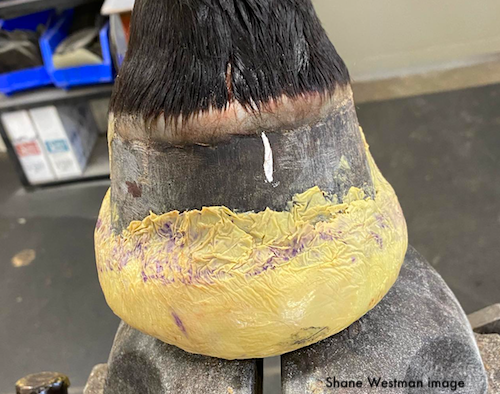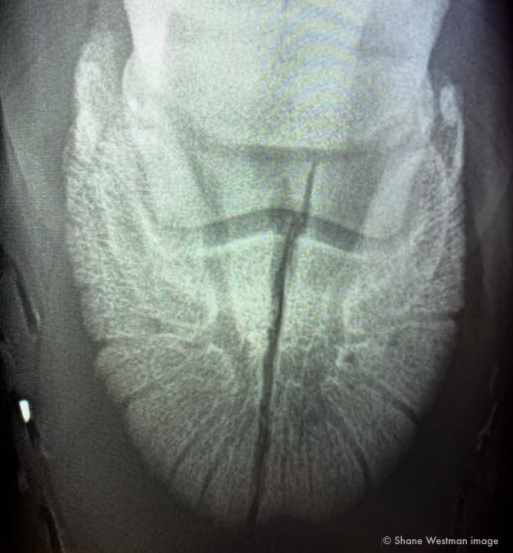 |
| Shane Westman at work in his forge at the University of California Davis Large Animal Clinic. |
The movement to bring more data-driven science to the care of horses’ hooves is surging forward, and University of California Davis veterinary hospital farrier Shane Westman is helping lead the way.
With a keen interest in research, and the opportunities available to him through his staff position at Davis, Westman recently earned a Graduate Diploma in Equine Locomotor Research (GradDip ELR) through the Royal Veterinary College in Great Britain.
Westman completed the program in three years, while navigating complications caused by the COVID-19 pandemic that interrupted class schedules and limited travel for Shane to the course satellite site for US farrier candidates at the University of Pennsylvania's New Bolton Center.
The course provides participants with scientific and academic skills to produce original research to the highest professional standard. Topics range from academic writing and communication skills to data processing and analysis. The course was conceived and led by Professor Renate Weller, who was then at the RVC. Weller is now dean of the vet school at Canada's University of Calgary.
“My goal is to utilize these new skills to help with my everyday practice at the university,” said Westman. “Combining these objective approaches with advanced equipment at a state of the art facility like the UC Davis veterinary hospital could help expand the knowledge base of what we do as farriers.”
Shane's research on farriery for P3 fractures
The final module of the course requires participants to undertake an original research project. Westman’s study, formally titled “Effect of an adhered fiberglass and methyl methacrylate solar-hoof casting technique on stabilization of type III distal phalanx fractures,” investigated a hoof casting technique for stabilizing coffin bone fractures.
This novel approach is a technique that Shane said he learned from fellow farrier Wes Champagne, who specializes in racehorse hoof repair in Southern California.
Westman shared that the casting technique has been used successfully in the clinic, but the aim of his study was to collect data to determine if the glue and fiberglass material that is bonded to the hoof sole and hoof wall (not just wrapped around the hoof) stabilized the bone fragments in the hoof capsule. He plans to submit his research to a peer-reviewed veterinary journal.
 |
| Shane used Lord 402/17 PMMA adhesive to coat and mix with the fiberglas, covering the sole of the foot, with the frog exposed. |
To complete this research, Westman worked closely with UC Davis equine surgery residents Drs. Tom Cullen, Thomas Bergstrom, and Lisa Edwards, with guidance from Research Engineer Tanya Garcia-Nolen, under the mentorship of Dr. Susan Stover, director of the J.D. Wheat Veterinary Orthopedic Research Laboratory.
 |
| The cast covers the sole but also extends up the hoof wall, creating a stable, bonded casement for the fractured bone within. |
“Shane’s vision was realized as a result of his ambition and innovation, along with the resources, people, equipment, and facilities at UC Davis that enable these types of research projects,” said Stover. “The team environment supports learning and facilitates advances on many levels.”
The knowledge that Westman gained through this program will provide UC Davis veterinary students, residents, faculty, and patients with access to advanced approaches to clinical care.
“I want to use this new knowledge and the tools and resources that I have at the university to expand the knowledge base of what we do as farriers,” said Westman. “I really enjoy helping the students, residents, and faculty with research ideas and implementation, and look forward to being a more valuable contributor to the team.”
“This remarkable achievement is the result of Shane’s passion for his role as a therapeutic farrier,” said LAC Director Dr. Bret McNabb. “We are fortunate to have someone on our team whose interests and dedication to equine podiatry serve our clients in delivering world-class care to their horses while providing unique training opportunities for future veterinarians.”
“Shane’s vision was realized as a result of his ambition and innovation, along with the resources, people, equipment, and facilities at UC Davis that enable these types of research projects. The team environment supports learning and facilitates advances on many levels.” --Dr Sue Stover
Westman is one of only two farriers in the western United States to boast this credential, the other being Tim Shannon, past distinguished UC Davis Annual Charles Heumphreus Memorial Lecturer.
The UC Davis Center for Equine Health provided partial support for Westman’s training.
Farriery moves forward at UC Davis
The UC Davis farrier shop at the hospital’s Large Animal Clinic (LAC) plays an integral part of providing high-level diagnostics and cutting-edge therapeutic services to UC Davis clients. In the future, farrier services at the vet school will become more integrated into equine care, in the Veterinary Medical Center’s new Equine Performance and Rehabilitation Center.
A vital component of the center will be the incorporation of a new farrier shop located adjacent to clinical facilities to provide immediate access to advanced hoof care.
This article was written by Amy Young at UC Davis, and lightly edited with additional photos, for Hoof Blog readers.
 © Fran Jurga and Hoofcare Publishing; you are reading the online news for Hoofcare and Lameness Publishing. Please, no re-use of text or images without permission--please share links or use social media sharing instead. Do not copy and paste text or images--thank you! (Please ask if you would like to receive permission.)
© Fran Jurga and Hoofcare Publishing; you are reading the online news for Hoofcare and Lameness Publishing. Please, no re-use of text or images without permission--please share links or use social media sharing instead. Do not copy and paste text or images--thank you! (Please ask if you would like to receive permission.)Questions or problems with this site? Click here to send an email hoofblog@gmail.com.
 |
| HoofSearch is a monthly report linking you to all new peer-reviewed hoof-related research from the previous month. Click here to learn more and start your subscription. |
Follow Hoofcare + Lameness on Twitter: @HoofBlog
Read this blog's headlines on the Hoofcare + Lameness Facebook Page
Enjoy images from via our Instagram account.
Disclosure of Material Connection: Hoofcare Publishing has not received any direct compensation for writing this post. Hoofcare Publishing has no material connection to third party brands, products, or services mentioned. I am disclosing this in accordance with the Federal Trade Commission’s 16 CFR, Part 255: Guides Concerning the Use of Endorsements and Testimonials in Advertising.





